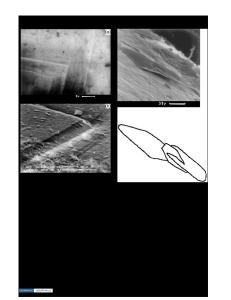Synthesis and characterization of Sr 1-x Ba x Bi 2 Ta 2 O 9 materials
- PDF / 215,279 Bytes
- 4 Pages / 612 x 792 pts (letter) Page_size
- 15 Downloads / 496 Views
P.S. Dobal and R.S. Katiyar Physics Department, University of Puerto Rico, San Juan, Puerto Rico 00931-3343 (Received 10 December 1999; accepted 2 June 2000)
Due to its endurance to ferroelectric fatigue, SrBi2Ta2O9 (SBT) has been extensively investigated. We report here the synthesis of Sr1−xBaxBi2Ta2O9 (x ⳱ 0.0, 0.1, 0.5, 1.0) using a solution-based route. The precursors used in this work were the salts of strontium, barium, bismuth, and tantalum ethoxide. X-ray diffraction and Raman spectroscopic studies indicated the formation of complete solid solution system for Sr1−xBaxBi2Ta2O9. This material system may provide interesting properties relevant to microwave tuning and ferroelectric memory applications, which are under investigation.
Electroceramic materials based on oxides have applications in several important areas, including ferroelectricity, pizoelectricity, and microelectromechanical (MEM) devices. Despite great advancement in Pb(Zr,Ti)O3 (PZT) based ferroelectric memory, the degradation of polarization switching has been an obstacle. Since the 90° domain is more likely to be pinned than the 180° domain,1,2 bismuth-containing layered oxides are considered as an alternative for PZT. It is well known that the barium ion can be replaced by a strontium ion in the perovskite structure to form a solid solution of BaxSr1−xTiO3 (BSTO), which also shows the ferroelectric effect3 for low strontium concentrations. Aurivillius phase materials, consisting of alternating perovskitelike An−1BnO3n−1 and fluoritelike Bi2O3 layers, where A is a mono-, di-, or trivalent cation, B is a cation with valence of 4, 5, or 6, and n is the number of perovskite layers, are potentially important for ferroelectric and dielectric devices. Because of good fatigue endurance4,5 in SrBi2Ta2O9 (SBT), this and related pseudo-orthorhombic compounds have been synthesized by several techniques,6,7 for ferroelectric devices. It is expected that Sr1−xBaxBi2Ta2O9 will provide tunable properties, but it has not been systematically investigated. We report here the synthesis of Sr1−xBaxBi2Ta2O9 by a solution method and its characterization using x-ray diffraction and Raman spectroscopy. For the synthesis, reagent-grade chemicals of barium hydroxide [Ba(OH 2 ) ⭈ H 2 O], strontium hydroxide [Sr(OH2) ⭈ 8H2O], bismuth acetate [Bi(OOCCH3)3], and tantalum ethoxide [Ta(OC2H5)5] were chosen as sources of barium, strontium, bismuth, and tantalum, respectively, with methoxyethanol (C3H8O2), 2-ethylhexanoic acid, and acetic acid as solvents. The stoichiometric ratios of the desired compositions were dissolved in proper volume ratios
a)
Address all correspondence to this author. e-mail: [email protected] J. Mater. Res., Vol. 15, No. 8, Aug 2000
http://journals.cambridge.org
Downloaded: 17 Feb 2015
of the solvents. The solutions of the individual salts and tantalum ethoxide were mixed hot and refluxed. A clear solution was thus achieved. A part of the refluxed solution was dried on a hot plate with constant stirring to make the powder. This powder
Data Loading...










